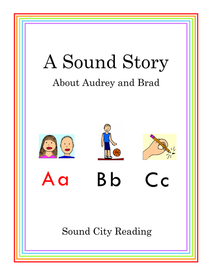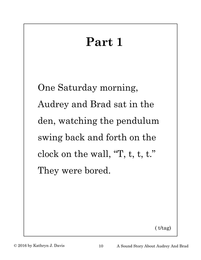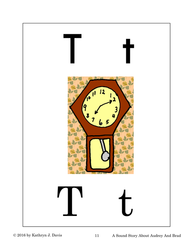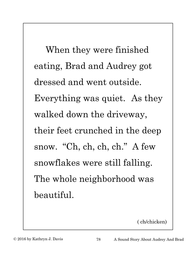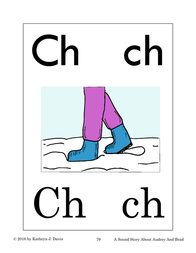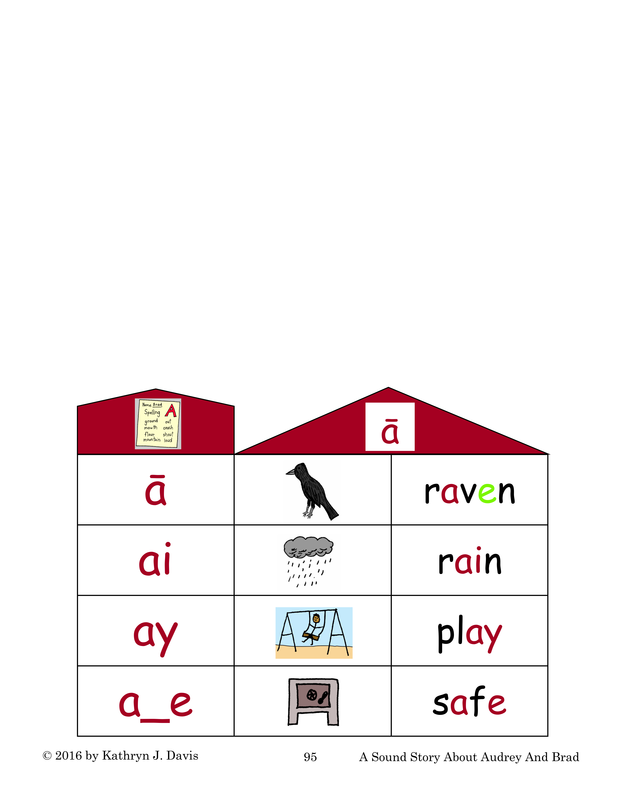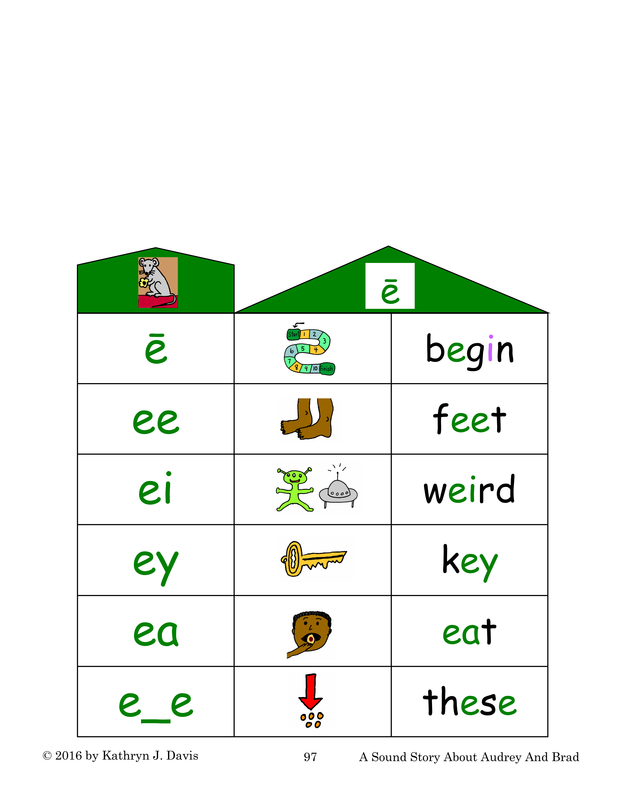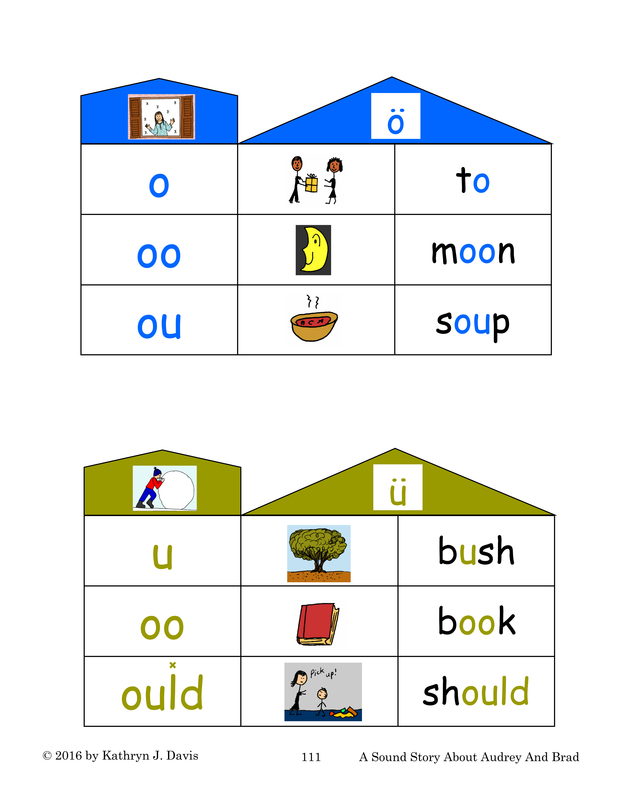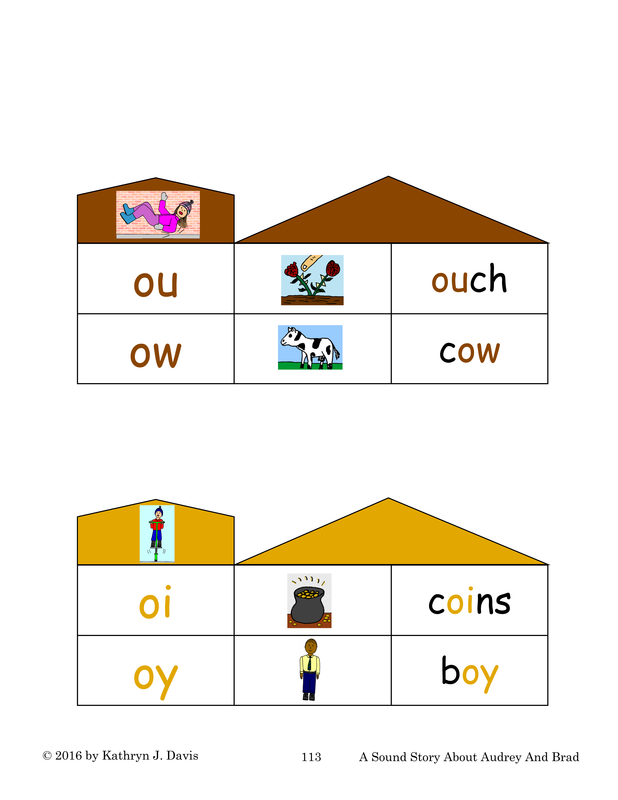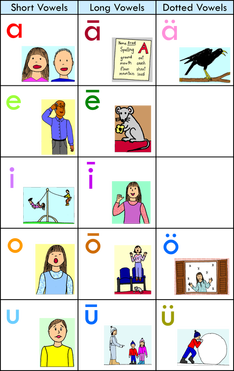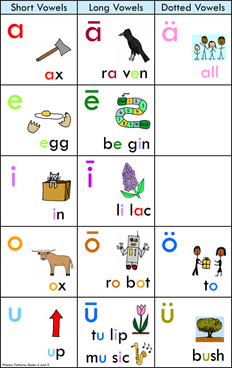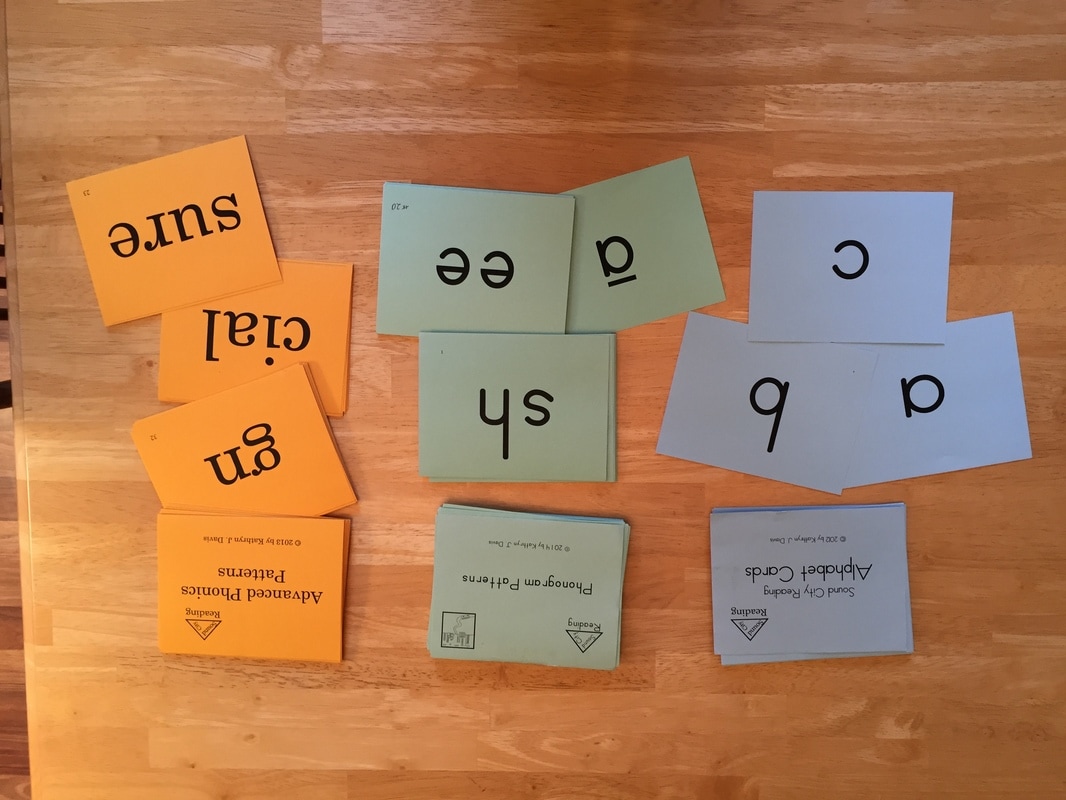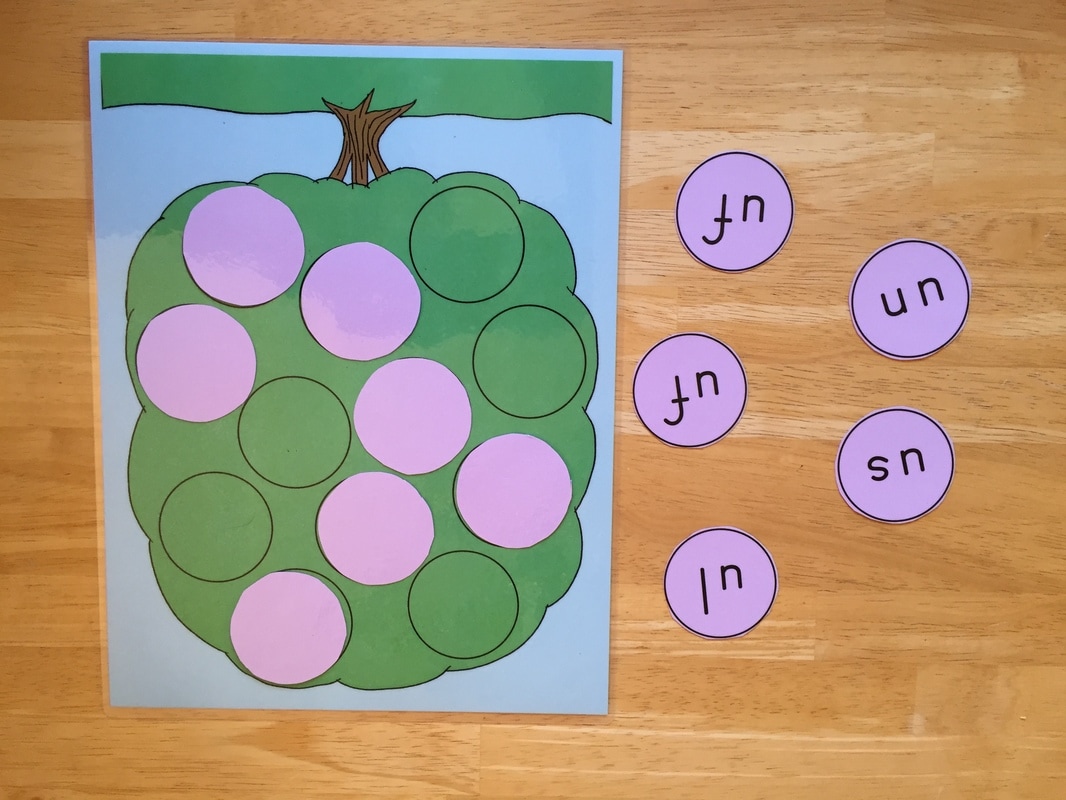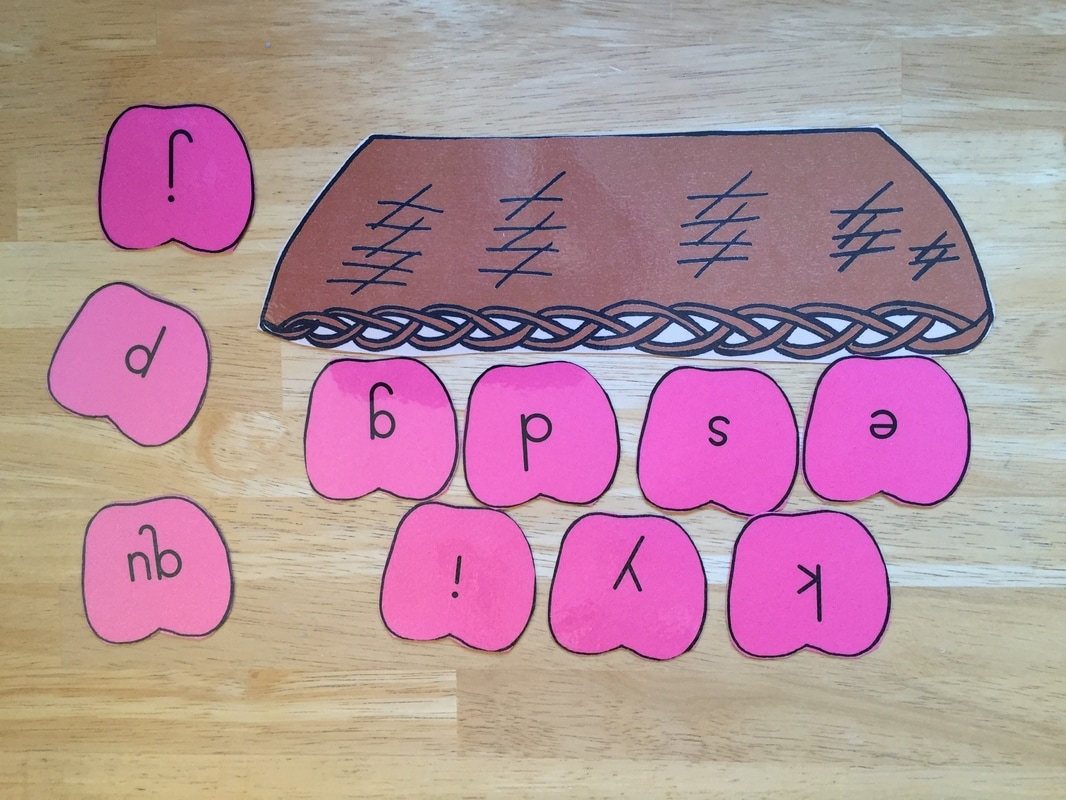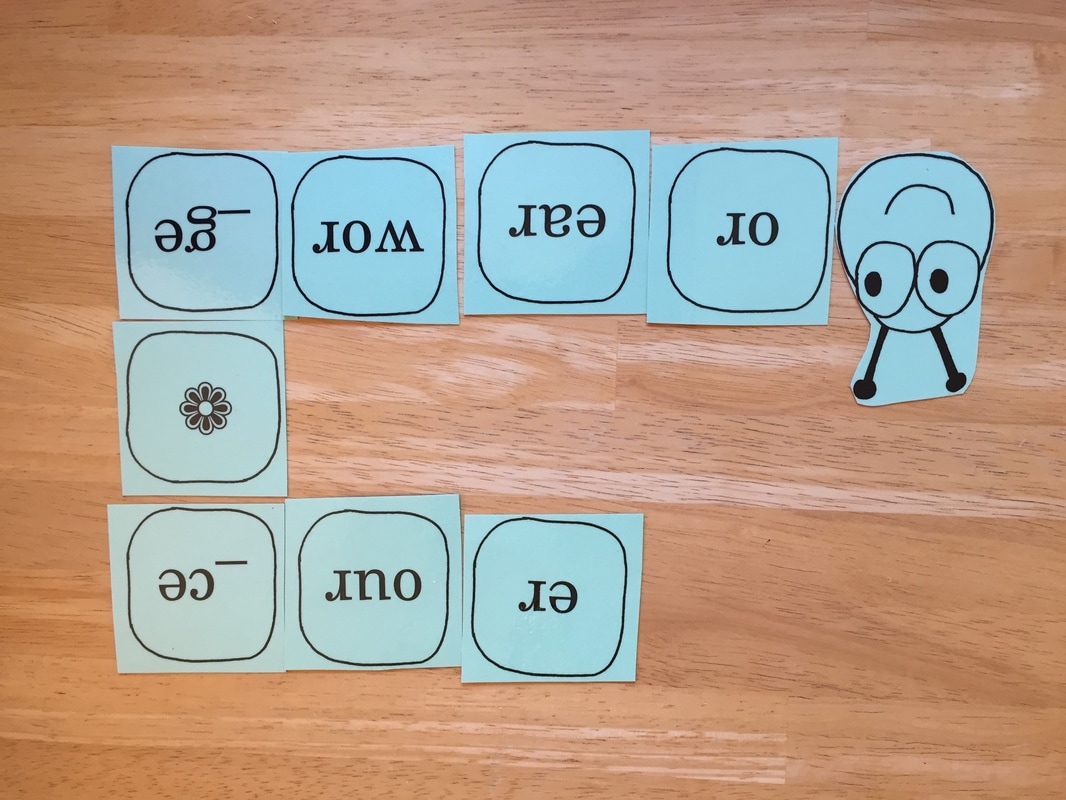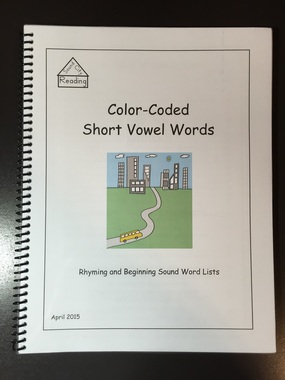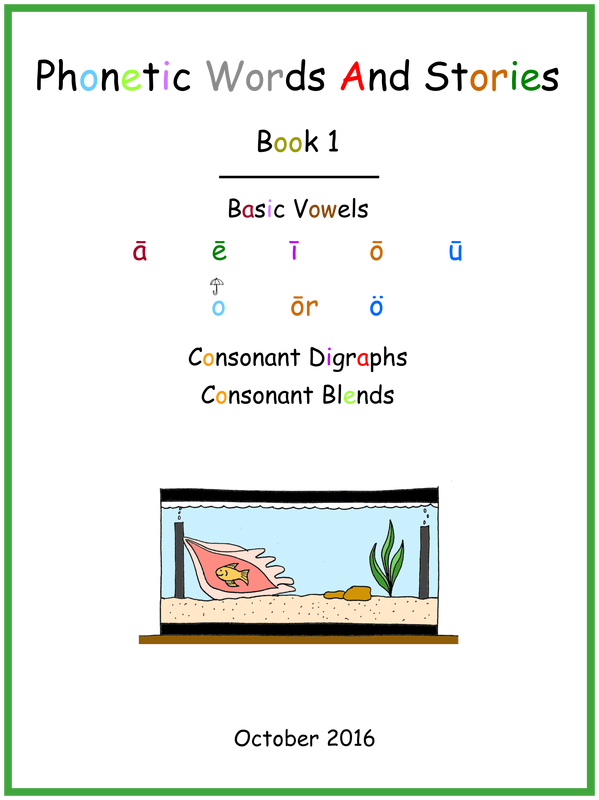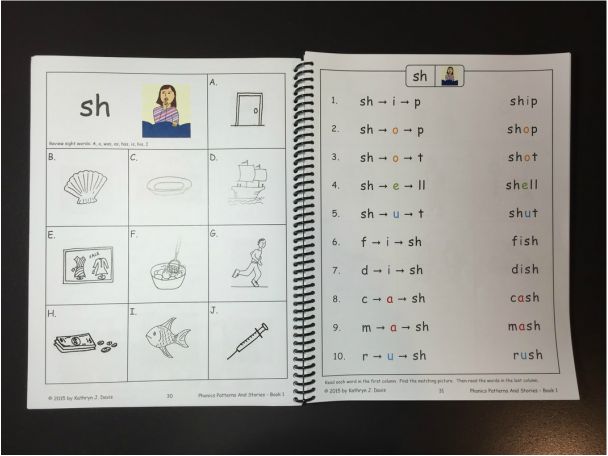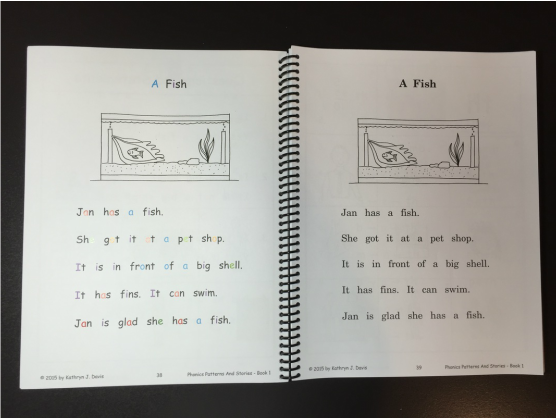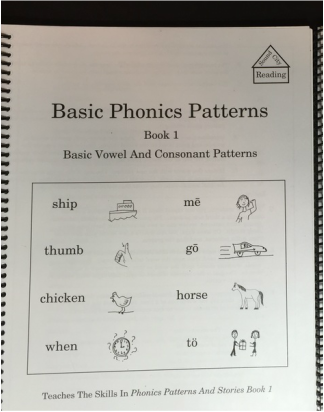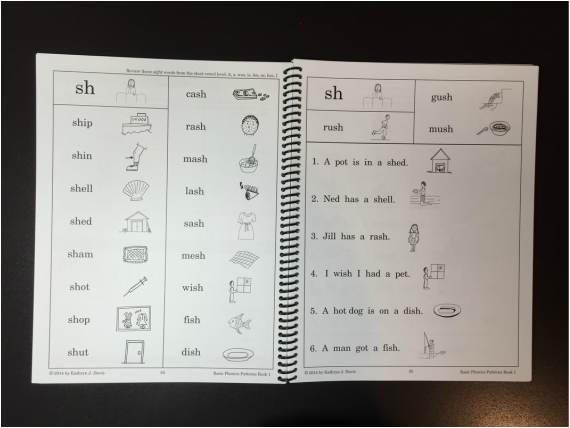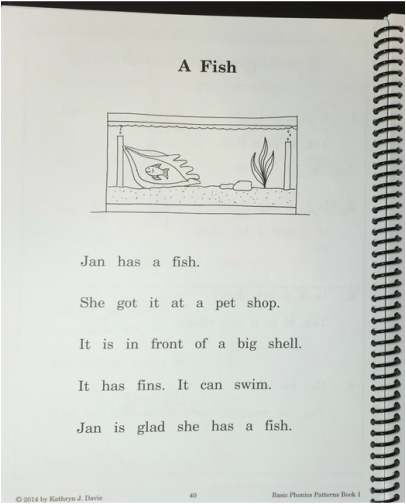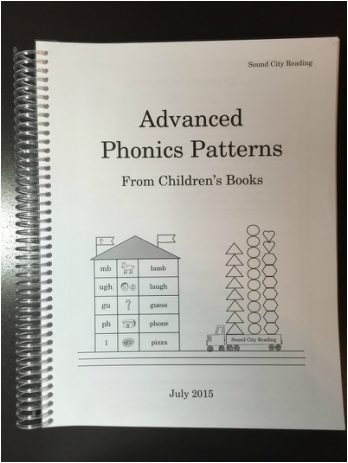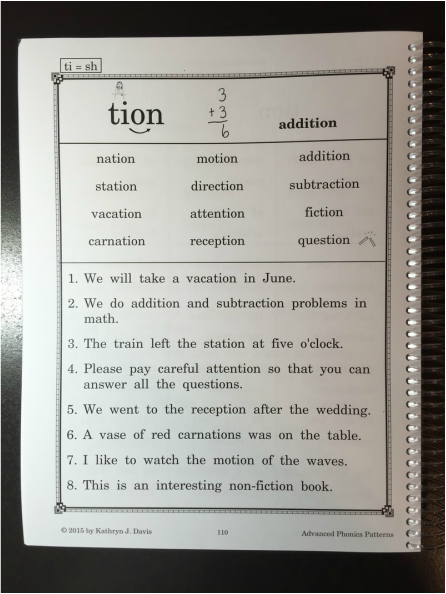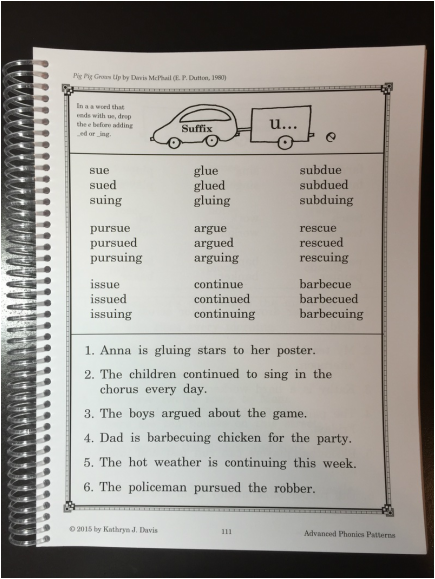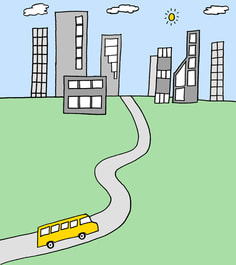Teaching Materials
Scroll down to see the books used at each teaching level.
Materials Used At All Levels
A Sound Story About Audrey And Brad Some Sound City Reading materials are used by students at all levels of instruction. This includes A Sound Story About Audrey And Brad which introduces all of the sounds in the English language, using pictures to represent specific speech sounds. For example, students see a dog growling (r sound), the wind blowing (w sound), and a bouncing ball (b sound). Each picture is paired with the capital and lower case letters (in two different fonts) that represent that sound in words. The teacher reads each section of the story aloud and points out the picture and letters, giving their sounds. Students listen and watch, repeating the sound as the teacher points to the picture and the letters.
|
Sound charts are included at the end of the book that show all the possible letter patterns that can represent each vowel sound. These can be removed and posted on the wall to create a "Sound City."
Sound Charts, Sound Cards, And Games
|
Wall Charts
|
Other Sound City Reading materials used at all levels include large versions of the sound charts that are in the books to hang on the wall in a classroom, letter and phonogram flashcards, and games to help students remember the alphabet and phonogram sounds. Games vary from one level to the next and are designed to reinforce the alphabet letters and phonogram patterns taught at that level. Note: A phonogram is a written symbol that represents a sound. Letters are phonograms, and letter patterns, such as sh, th, ee, igh, and oy are also phonograms. |
Sorry, I cannot get these pictures to appear right side up. This section still under construction!
Color-Coded Short Vowel Lists
|
Color-Coded Short Vowel Lists
|
Level 4 - Phonics Patterns
After students have learned the letters of the alphabet and learned to read and spell short vowel words, they must learn the many additional phonics patterns (phonograms) used to represent sounds in words. There are three different sets of books to teach these patterns. Each set teaches the patterns in the same order but has a completely different format. This allows the teacher to adjust instruction to the students' needs. Short, illustrated practice stories are included in every set. The three sets are listed here. See more information about each set under the subheadings below.
An additional book, Color-Coded Phonetic Lists, may be used as a supplement for additional decoding practice.
The phonics (phonogram) patterns are taught in a logical, sequential order. The most common, most needed, and easiest patterns are taught first. The less common patterns are taught later. Patterns that are similar are grouped together, providing a logical framework to help students learn them and apply them as they read.
Students not only learn to read words with each new phonetic pattern, they also learn to spell them. To spell a word, students say each sound, in order, as they simultaneously write the related letters and letter patterns. As they say the individual sounds, students are segmenting the word. This is a fundamental phonemic awareness skill that opens the door to reading and writing.
A few sight words are taught as exceptions to the rules after a new phonetic pattern has been taught. For example, after learning to read words with the ee pattern (see, feet, keep...) students learn the sight word been. After learning the ai pattern (rain, paid, sail...) students learn the sight word said.
After students have studied several new phonetic patterns and related sight words, they read a short practice story containing words with those patterns.
The first part of each book contains sound charts which show all of the phonetic patterns taught so far, including new and review patterns. On the charts, each phonogram is paired with a sound picture from the sound story. For example, a picture of a growling dog shows the /r/ sound, a squeaking mouse shows the long /ee/ sound, and a crow shows the /aw/ sound. Students say the sounds from the charts as the teacher points to each pattern. The sound charts are expanded to include new patterns as students progress through the books. The last books will contain more charts than the first books. Enlarged wall charts, showing the same letter patterns and sound pictures, are available to use in a classroom (see Materials Used At All Levels, above).
After reviewing the charts the teacher uses a set of phonogram flashcards to review the same patterns. This time students must recognize the patterns and say the sounds without picture cues.
There are many patterns to learn, and daily review using the charts and phonogram cards provides the reinforcement needed for students to internalize the patterns so that they can apply them when reading and writing.
Students can also play a learning game, the Caterpillar Game, in small groups to help them remember the patterns and their sounds.
The patterns are taught quickly, about one new pattern per day for first graders, so that students will be able to begin reading real books as soon as possible. Second graders may be able to cover two or three patterns per day.
As soon as students learn enough patterns, students can begin reading several "easy to read" trade books. These are listed in the sequence charts. For students who are already reading, provide opportunities to read books and stories at the appropriate reading level from the start.
As they work through the program, students will also learn to read multi-syllable words, contractions, and words with suffixes.
- Phonetic Words And Stories, Books 1-8 (Very large, color-coded print, the words are illustrated, with ten words per pattern)
- Basic Phonics Patterns, Books 1-8 (Large all black print, the words are illustrated, with more than ten words per pattern)
- Know The Phonetic Code, Volumes 1-3 (Medium all black print, the words are not illustrated, with advanced word lists)
An additional book, Color-Coded Phonetic Lists, may be used as a supplement for additional decoding practice.
The phonics (phonogram) patterns are taught in a logical, sequential order. The most common, most needed, and easiest patterns are taught first. The less common patterns are taught later. Patterns that are similar are grouped together, providing a logical framework to help students learn them and apply them as they read.
Students not only learn to read words with each new phonetic pattern, they also learn to spell them. To spell a word, students say each sound, in order, as they simultaneously write the related letters and letter patterns. As they say the individual sounds, students are segmenting the word. This is a fundamental phonemic awareness skill that opens the door to reading and writing.
A few sight words are taught as exceptions to the rules after a new phonetic pattern has been taught. For example, after learning to read words with the ee pattern (see, feet, keep...) students learn the sight word been. After learning the ai pattern (rain, paid, sail...) students learn the sight word said.
After students have studied several new phonetic patterns and related sight words, they read a short practice story containing words with those patterns.
The first part of each book contains sound charts which show all of the phonetic patterns taught so far, including new and review patterns. On the charts, each phonogram is paired with a sound picture from the sound story. For example, a picture of a growling dog shows the /r/ sound, a squeaking mouse shows the long /ee/ sound, and a crow shows the /aw/ sound. Students say the sounds from the charts as the teacher points to each pattern. The sound charts are expanded to include new patterns as students progress through the books. The last books will contain more charts than the first books. Enlarged wall charts, showing the same letter patterns and sound pictures, are available to use in a classroom (see Materials Used At All Levels, above).
After reviewing the charts the teacher uses a set of phonogram flashcards to review the same patterns. This time students must recognize the patterns and say the sounds without picture cues.
There are many patterns to learn, and daily review using the charts and phonogram cards provides the reinforcement needed for students to internalize the patterns so that they can apply them when reading and writing.
Students can also play a learning game, the Caterpillar Game, in small groups to help them remember the patterns and their sounds.
The patterns are taught quickly, about one new pattern per day for first graders, so that students will be able to begin reading real books as soon as possible. Second graders may be able to cover two or three patterns per day.
As soon as students learn enough patterns, students can begin reading several "easy to read" trade books. These are listed in the sequence charts. For students who are already reading, provide opportunities to read books and stories at the appropriate reading level from the start.
As they work through the program, students will also learn to read multi-syllable words, contractions, and words with suffixes.
Phonetic Words And Stories - Book 1 - 8
|
The Phonetic Words and Stories books may be used after students have learned to read short vowel words. They work well with beginning readers and also with students who are already reading but need more practice to strengthen their spelling and decoding skills. This set of books has the largest print. Students are able to learn more easily when the text for the initial instruction is large enough.
Each new pattern is taught with a set if ten color-coded words. This gives enough practice for each new pattern without being overwhelming. Each vowel sound is printed in a different color. This make the vowel pattern "pop out" within the word so the students can see it clearly. The colors provide a cue to help students remember the vowel sound. For example, each short vowel is printed in a specific pale color. The related long vowel is a darker shade of the same color. |
Phonetic Words And Stories
|
The colors help students organize their thinking as they learn new patterns. Patterns that have the same sound are printed in the same color. For example, the ai, ay, and a_e patterns are all printed in a dark red color. Sometimes one pattern can show two or more different sounds, and the color-coding is helpful for these words as well. For example, the ow pattern in the word cow is brown, while the ow pattern in the word slow is dark orange to show the long o sound.
Each set of words is shown with matching pictures on the opposite page. However the words and pictures are not in the same order. This allows the teacher and students to do various activities reinforcing phonemic awareness and decoding skills. One of these activities is called the "Robot Game." The activities can be adjusted to the students' current level, depending on how much support the students need as they learn the words. After doing the activities students will usually be able to read the words on the page.
Each set of words is shown with matching pictures on the opposite page. However the words and pictures are not in the same order. This allows the teacher and students to do various activities reinforcing phonemic awareness and decoding skills. One of these activities is called the "Robot Game." The activities can be adjusted to the students' current level, depending on how much support the students need as they learn the words. After doing the activities students will usually be able to read the words on the page.
Basic Phonics Patterns - Books 1 - 8
|
The Basic Phonics Patterns, Books 1 - 8 have all black print. The word lists usually contain more than ten words. Each word is illustrated, with a small picture directly beside the word. There are also a few sentences for students to read as they study each new pattern. Students read the same short practice stories, but the words are not color-coded.
This set of books works well for students are able to decode new words comfortably. With the longer word lists, additional sentences, and all black print, the books provide a greater challenge compared to the Phonetic Words And Stories books. The Basic Phonics Patterns books can be used for initial instruction or as extra practice after students have been introduced to the patterns in the Phonetic Words And Stories books. Because they are printed in all black print they can be easily copied for take home reading practice pages. |
Color-Coded Phonetic Lists
Another book, Color-Coded Phonetic Lists, covers all the patterns taught in books one through eight. The vowel pattern in each word is color-coded. Patterns that are printed in the same color sound alike. It includes both rhyming and body-coda (same beginning sounds) word lists. The words are not illustrated, and there are no sentences or stories. The word lists are designed to build decoding fluency for each new pattern that students study. They should be used in conjunction with either the Phonetic Words And Stories books or the Basic Phonics Patterns books, or with both.
Know The Phonetic Code - Volumes 1, 2, And 3
These books are printed in smaller, all black print. The word lists are not illustrated, and there are no sentences, but the same practice stories found in the Phonetic Words And Stories and Basic Phonics Patterns books are included and they are illustrated. The word lists are set up so that students read one column of one-syllable words for each phonetic pattern, along with a number of two-syllable words that contain the pattern.
Know The Phonetic Code - All
This book is also printed in smaller, all black print. However in this book there are no practice stories. This makes it possible to fit word lists for all of the phonetic patterns, including short vowels, phonics patterns, and advanced phonics patterns, in one book. The word lists are set up so that students read one column of one-syllable words for each phonetic pattern, along with a number of two-syllable words that contain the pattern. This book can be used as a challenge level for students who are learning the phonetic patterns or as a review book for students who are studying Advanced Phonics Patterns From Children's Books.
Level 5 - Advanced Phonics Patterns
Advanced Phonics Patterns From Children's Books
|
Students work through the Advanced Phonics Patterns book to learn the rest of the phonics patterns (patterns that are less common), more suffixes and prefixes, and common ending syllables (tion/nation, cial/special, sure/pressure, etc.) The book has all black print. Students read a set of words and sentences for each new pattern. The words are not illustrated. Using sound charts, flashcards, and games, students review recent and previously learned phonics patterns.
Each new set of patterns prepares students to read a new trade book. The list of trade books includes eight-one popular children's picture books, ranging from the first grade through the fourth grade reading levels. Students are ready to read each new book after they have studied all of the phonetic patterns needed to read the words in the book. Trade books must be checked out of the library or purchased separately. |
